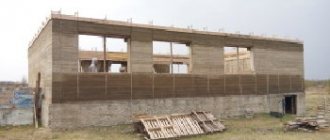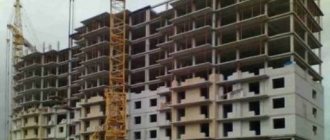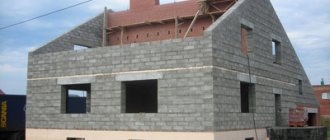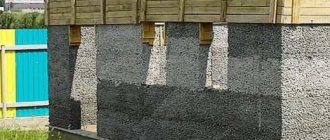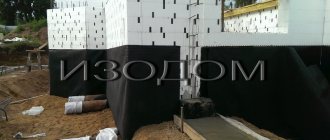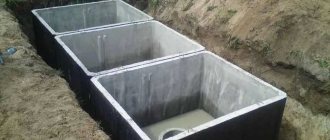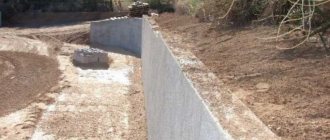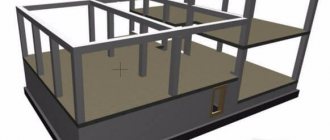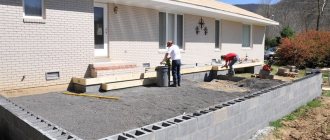The plinth protects the building from getting wet and prevents water from penetrating from the surface of the earth into living spaces. The presence of this structural element is a very important issue if we are talking about wooden houses, because with constant exposure to moisture they collapse and become unusable. The space under the floor of the first floor acts as a certain buffer, which absorbs the main effects of moisture, thereby protecting the floors of the structure. One of the popular options for the construction of country houses is a monolithic base made of reinforced concrete. Often the base element is the top of the strip foundation.
The fact is that it is the monolithic base that is the most reliable design option with high strength characteristics. It is made of reinforced concrete, so it is one with the foundation of the building. A monolithic base can be built using formwork and concrete mortar.
As for the financial side of the issue, it is difficult to say for sure what will be cheaper - a monolithic plinth or a plinth made of bricks or blocks. A variety of materials can be used for construction, which have different costs. You should not skimp on the quality of building materials.
Additional attention should be paid to the strength and performance characteristics of thermal insulation and waterproofing materials and compounds that will protect the basement and foundation from water and cold air.
Monolithic reinforced concrete plinth - features and construction technology
The plinth protects the building from getting wet and prevents water from penetrating from the surface of the earth into living spaces. The presence of this structural element is a very important issue if we are talking about wooden houses, because with constant exposure to moisture they collapse and become unusable. The space under the floor of the first floor acts as a certain buffer, which absorbs the main effects of moisture, thereby protecting the floors of the structure. One of the popular options for the construction of country houses is a monolithic base made of reinforced concrete. Often the base element is the top of the strip foundation.
The fact is that it is the monolithic base that is the most reliable design option with high strength characteristics. It is made of reinforced concrete, so it is one with the foundation of the building. A monolithic base can be built using formwork and concrete mortar.
As for the financial side of the issue, it is difficult to say for sure what will be cheaper - a monolithic plinth or a plinth made of bricks or blocks. A variety of materials can be used for construction, which have different costs. You should not skimp on the quality of building materials.
Additional attention should be paid to the strength and performance characteristics of thermal insulation and waterproofing materials and compounds that will protect the basement and foundation from water and cold air.
Features of a monolithic base
The height of the base can be different, so construction should be carried out taking this indicator into account. The height of the base above the foundation is determined based on the presence or absence of an underground floor, underground floor, sewer system, roof structure, presence of blind areas, etc. As a rule, this figure does not exceed 150–200 cm.
The concrete plinth is characterized by high reliability indicators.
When building a basement, special attention should be paid to the presence of vents and openings for the output of communications. You can make ventilation holes yourself. To do this, they must be provided when pouring concrete. These holes should be located at a distance of 20–25 cm from the ground. If the house is small, then you can make holes in increments of 2–3 meters.
The construction of a monolithic basement floor has many advantages:
- good protection against water penetration;
- increased strength indicators;
- simplicity and short construction time.
In the basement with concrete walls, premises for various purposes can be located, from a sauna and bathhouse to a garage or laundry room.
Do not forget about the installation of high-quality waterproofing, with the help of which a monolithic base can be made even on wet ground. These works can be done with your own hands. It is necessary to take into account the fact that the most vulnerable places will be the junction of the floor and the walls of the basement. Therefore, they need to be given special attention.
Construction of a monolithic base
The construction of monolithic plinths is carried out in several main stages.
Site and pit preparation
The area that has been selected for construction work is marked. After which a pit is dug across the entire area of the future building. The project will regulate the depth of the pit, but it must exceed the depth of the foundation by 50–60 cm. This is required so that a sand cushion can be made, which will subsequently drain groundwater and prevent soil heaving from affecting the structure.
Ready foundation pit for construction.
When the excavator digs a pit, you need to ensure that the pit is deepened evenly. In this regard, it is advisable to remove the last 50–80 cm of soil with your own hands. Construction is complicated by the fact that it is impossible to fill overly buried areas, because this can cause deformation of the slab.
If the groundwater level is high, the hole will fill with water. In this case, it is necessary to make a drainage system, which should be located some distance from the pit. If there is quicksand in the ground, then it must have an individual drain. It is very important here to prevent the water from stagnating. The backfill should be made alternately from a crushed stone or gravel layer and a layer of sand. Each layer should be about 10–15 cm thick. Sand and gravel need to be compacted.
Pouring the base
A monolithic base is poured onto the prepared sand and gravel bed. For this purpose, as a rule, lightweight concrete is used. In this case, the thickness of the concrete layer should be about 5 cm. This layer will act as waterproofing. In addition, it will level the base for the slab. As soon as the concrete has hardened, construction continues by laying a waterproofing layer (rolled materials are suitable for this). The waterproofing material is laid in 2–3 layers. Roofing felt must be glued to mastic. You can do this yourself.
Once the base is prepared, construction continues with the installation of external formwork for the floor slab. This slab will become a kind of support for fastening the foundation walls. Almost any boards can be used for formwork; they are connected to each other with bars and nails.
The construction of a monolithic foundation will be incomplete if you do not provide reinforcement. For this, corrugated reinforcement with a rod diameter of 10 cm works best. The reinforcement is mounted on guides. The rods should be secured with wire, using a special hook, or with your own hands using available tools. In those areas where walls will be located, it is recommended to install the reinforcement vertically to ensure the most reliable connection with the monolithic slab.
Hook for tying reinforcement.
After the formwork has been prepared, the pouring of concrete grades M250–300 begins, which will ultimately form a foundation slab about 20 cm thick. In most cases, the slab needs to be poured in one go. Of course, pouring in parts is allowed, but this will reduce the strength of the foundation, so high-stress seams may appear.
As soon as all the concrete has been poured, the solution is punched using a vibrating screed, the surface of the base is leveled, and then left for 4-5 weeks to harden. To ensure that construction does not stop at this stage, formwork for the walls begins to be made a few days later.
Filling the walls
To install the formwork for the walls of the underground floor, it is recommended to purchase permanent polypropylene panels, which will act as an additional heat insulator, which is very important when equipping a living space, if one is planned according to the construction plan.
At this stage, the walls are also reinforced. It is performed longitudinally, the reinforcing bars are connected to the previously installed vertical reinforcement. If the height of the foundation reaches 250 cm, then it is necessary to make two reinforcing belts, which should be located below and above. If construction is carried out on heaving soil, then there may be several additional reinforcing belts.
In the process of creating formwork, it is necessary to provide for the presence of openings for doors and windows, which is also necessarily indicated in the project. In addition, areas for communication pipes must be marked.
An example of using permanent formwork, which also serves as insulation.
It is worth noting that pouring concrete, even if you do it yourself, should be done immediately. If this is not possible, then concrete is poured in layers. When pouring layer by layer, you need to wait 3-4 days before the previous layer sets. This approach will eliminate the subsequent destruction of the foundation, which has not had time to gain adequate strength. Many people know that concrete will gain its strength within 4-5 weeks. Only after this will it be possible to carry out subsequent construction and installation of floors.
Waterproofing works and insulation
The waterproofing layer of the basement floor is carried out by coating or pasting the surface. When carrying out interior work, it is recommended to use penetrating waterproofing materials that will not interfere with vapor exchange. When carrying out external work, the base is usually insulated with expanded polystyrene, which must be fixed with a special adhesive composition. Additional fastening of the slabs can be achieved using self-tapping screws or dowel nails.
The monolithic concrete base is covered with waterproofing and insulated.
In some cases (when there is no alternative), backfilling can be done with your own hands using soil that was extracted by an excavator when digging a hole for the foundation. But if the extracted soil contains any solid inclusions that could potentially harm waterproofing or thermal insulation materials, it would be best to use coarse sand to backfill.
The installation of a monolithic basement floor can be done with your own hands, however, at almost all stages of the work you will need the help of partners and special knowledge.
podvaldoma.ru
Possible errors and difficulties of the process
The installation of a plinth is an important stage in house construction; the trouble-free service life of the house will depend on its quality and the completeness of the execution of the technological map. Construction can begin only if a construction project has been developed and approved and material has been purchased according to design specifications.
In addition, the contractor must have the appropriate permits for the right to carry out such work and have a developed technological map for the construction of the basement of the house.
Errors when constructing a plinth from concrete blocks are in most cases fatal, which are either impossible to correct at all, or will be very difficult and expensive.
The main mistakes that are made by workers when constructing a plinth from concrete blocks:
- Incorrect foundation type selected. Building elements, especially those made of aerated concrete, are not the most resistant to bending. If the base on which the plinth will rest is not sufficiently rigid and reliable, contains significant indentations in geometry, and does not correspond to the type of soil and topography of the area at the construction site, then the masonry in some places can bend and crack.
- Violation when laying the 1st row of blocks. It ensures the geometry of the entire masonry, if during its construction there are significant deviations in height or the diagonals are shifted, in subsequent rows these errors cannot be corrected; on the contrary, they will only increase. The first row is allowed to be laid on the CPR in a layer of up to 20 mm, but if the foundation has a horizontal difference of up to 30 mm, the CPR will not be able to level it - you will have to level the foundation and only then start laying.
- Violations in the waterproofing of the 1st row, there is no bitumen waterproofing between the wall and the foundation.
- The masonry mortar was chosen incorrectly, especially for aerated concrete, or cheap, low-quality glue was purchased, which creates large heat losses through the wall structures of the plinth.
- Mistakes were made when tying the blocks; as a result, the masonry is not able to withstand the design bending and shearing forces. Russian regulatory requirements for dressing are at least 40% of the height of the block. So, for example, for wall elements 250 mm, the dressing should be at least 100 mm. and according to EU requirements - no less than 125 mm. It is also prohibited to use elements shorter than 50 mm for the construction of the plinth.
- The mating of load-bearing walls and partitions was performed incorrectly - a rigid mating was made using blocks or scraps of reinforcement hammered into the walls. Cracks will definitely appear in such areas.
- Lack of reinforcement for every fourth row, especially for gas blocks.
- Lack of armored belt or breaks in it
- Hydro- and thermal protection of external walls has not been completed.
Concrete plinth: how to pour concrete into a plinth
The plinth protects the building from dampness and prevents groundwater and flood water from entering the house. Its arrangement is especially important in wooden houses, which are most vulnerable to the harmful effects of moisture - they are subject to rotting of the structure and further destruction.
Underground spaces in houses play the role of a buffer, which absorbs the entire water impact of the environment, leaving the structure dry and warm.
The most common option for the construction of private houses has become a monolithic reinforced concrete base. In most cases, the top of the strip foundation acts as the plinth element.
It is the monolithic arrangement of a concrete plinth that is the most reliable option for the correct construction of a building with high strength characteristics. And since it is made of reinforced concrete, it is one with the foundation.
In this case, a concrete base can be built using formwork and concrete mortar. Concrete pouring, done according to all the rules, reliably resists moisture.
Advantages of the basement floor
The main advantage of the basement structure of the floor is its integrity with the rest of the building, not counting the laying of communications and horse and door openings.
It is rational to arrange the arrangement of exits and windows when located on slopes, when on one side the base is placed in the ground, and on the other it is located in open space.
In any case, the base is almost airtight, which ensures the building is waterproof, long service life and high strength of the entire structure.
The construction period of a concrete plinth is limited only by the hardening of the concrete. A warm, ventilated and dry basement floor is an additional usable area of the house that can be equipped depending on needs. Completely recessing the ground floor allows you to save on heating the entire house during the cold season.
The height of the plinth ensures that the house is raised above the surrounding landscape. In addition, a monolithic and sealed plinth can also be built on moving soils without fear of shear deformations.
Construction of a concrete plinth
The construction of a monolithic concrete plinth involves a certain sequence of work - preliminary preparation, digging a pit, laying a concrete floor, waterproofing work. And only then the monolithic walls of the basement are poured.
Preparatory work
First of all, find out the depth of water in the soil; the optimal distance would be 1.5 m or more. A house design with a monolithic concrete base is selected, the depth and width of the foundation walls are calculated.
The height of the underground premises and the depth of the depth determine the size of the foundation base and the minimum thickness of the walls.
The maximum height is considered to be 2.5 m. Movable soil and the proximity of groundwater will require additional arrangement of the drainage system, as well as better waterproofing.
Digging a pit
Mark a place for the future foundation pit. The depth of the pit should definitely be below the freezing level of the soil in the area, and also 0.5-0.6 meters deeper than the floor of the basement.
The pit is dug using special equipment, but the last 0.5 m is dug out manually so as not to damage the density of the soil and not change its compactness. Otherwise, deformation of the slab, which is the floor of the plinth and the foundation of the entire building, may occur.
After the pit is ready, it is inspected for the presence of water. It should be excluded from the pit. The surface of the pit is covered with 10 cm of crushed stone and a 1.-1.5 m layer of sand. The surface is leveled and watered several times to avoid voids.
After a week or a little more, the base of the basement floor is poured with concrete grade M 50...100 in a layer of 50 mm. As soon as the fill dries, it is greased with mastic and covered with waterproofing material. It is better to lay the sheets in several layers with overlapping edges.
Creating formwork
It is the designed formwork along the perimeter of the foundation that allows you to pour a monolithic floor of the basement with the subsequent construction of walls on it. The height of the formwork is about 150-200 mm.
When installing it, wooden beams with a thickness of 25 mm or more are used, as well as boards. The structure is fastened with self-tapping screws, using reinforcing struts around the perimeter. This enhanced form strength will support the weight of the concrete.
Strengthening the base and waterproofing
Using permanent formwork you can insulate and protect the basement floor. Geotextiles are attached to the inner layer to prevent concrete from protruding from the structure.
External waterproofing is carried out using penetrating materials, coating materials, rolls, and special screens. The choice of such materials is made based on the groundwater existing at the site.
As a rule, waterproofing is done in 2 layers, covering all surfaces related to the basement floor. Penetrating solutions are still more often used inside; they penetrate the structure of the base material and increase vapor permeability.
External insulation is made with slabs of foamed polystyrene laid on an adhesive layer. All mastics and bitumen coating are done with pre-heating of the materials. Rolled protective materials are installed either by pouring, or attached to bitumen mastics.
Reinforcement
To give strength to the frame, a two-level reinforcement frame is made. Its upper and lower edges are constructed from metal reinforcement bars laid in the longitudinal and transverse directions in increments of 20 cm.
Rods with a diameter of 10-16 cm are used with certain notches over the entire surface. During installation, they are tied at the intersections with wire, which gives elasticity to the concrete screed.
The frame is placed in the formwork, moving 2-3 cm from its edges. At the junction of the walls and the base, the reinforcement is made to come to the surface; in the future, this will help connect them to the floor reinforcement.
Pouring concrete
Strength is given to the base by pouring the entire mass of concrete at one time. It is necessary to select a solution of a grade not lower than M300. Concreting in layers will reduce the strength of the floor, since in this case the risk of cracks increases.
If this cannot be avoided, all joints should be made along the long wall of the house, waiting 3-4 days between layers for the concrete to harden. The pouring height is about 20 cm. The solution must be compacted. After 4 weeks, concrete gains up to 70% of its strength.
Installation of monolithic walls
Formwork for the construction of foundation walls can be done 5 days after the pouring is completed. This design is formed by shields with indispensable temporary supports. Immediately provide openings for windows, doors, technical openings for communications.
The height is either for the entire floor or for several rows. For strength, the formwork must be tightened with iron pins; in addition, they can be easily dismantled after pouring.
The arrangement of the external perimeter of the basement floor made of monolithic concrete is strengthened by the construction of internal partitions. They are reinforced with steel rods in increments of up to 31 cm. For the tie, rods standing vertically from the floor are taken.
The reinforcement is not welded, but rather bonded, to impart elasticity to the surfaces. For a typical height of 2.5 m, 2 reinforcing belts are allowed. After the filling is completed, the solution is left for 28 days, after which the overlapping is done.
That part of the surface that is on the outside is reinforced with dowels with plates. The underground part is filled with a layer of soil. But it should be taken into account that soil fractions should not disrupt the insulation from moisture and thermal protection. It is recommended to use sand.
Conclusion
With proper construction in compliance with all the rules, a monolithic concrete plinth will give the building special strength, stability and durability. By arranging such a ground floor according to your needs, you can get a full floor of the house for use.
Finishing the base and barbecue with a stone look (Decorative concrete)
propodval.ru
conclusions
To summarize, it is worth adding in any case the surface of a brick or reinforced concrete plinth must be protected from the effects of precipitation by the following set of measures:
- Arrangement of gable and eaves roof overhangs of at least 0.5 meters;
- Installation of an effective roof drainage system;
- Laying a blind area around the perimeter;
- Coating the surface of the base with bitumen mastic (cladding with ceramic tiles, porcelain stoneware, plastering or treatment with special primers is allowed).
How to make a brick plinth on a strip foundation
To protect the walls from the negative effects of surface water and mechanical damage, a plinth is installed. This is the name of the above-ground part of the foundation, directly on which the supporting structures of the building are erected.
Concrete, prefabricated reinforced concrete structures, etc. can be used as starting materials for construction.
For example, for wooden or frame houses, a brick base on a strip foundation is quite suitable - regardless of what material the strip is built from.
Purpose of the base
The basement is the foot of the building and is a continuation of the foundation. Usually it rises above ground level by at least half a meter.
The base performs two functions:
- utilitarian: protects the walls of the house from cold and moisture;
- aesthetic: gives the building an impressive appearance.
A house built without a basement looks squat and unsightly, so architects attach great importance to this part of the building. This is especially true for low-rise buildings.
In buildings with a basement, the base plays the role of its enclosing structures, and when installing a floor on the ground, it acts as a retaining wall, which takes on the pressure of the backfill and the load from the walls.
Some inexperienced builders are wondering: is it necessary to install a base on a strip foundation if there are no plans to install a basement in the house?
Both builders and designers answer unequivocally: it is necessary. Typically the tape is made flush with the ground level, so that without a plinth the walls will “stand on the ground”. And since no one has canceled the shrinkage process, the house will gradually grow into the ground.
Imagine such a picture, and you will no longer be tormented by the question of why brick plinths are installed on strip foundations (which brick is better for a foundation plinth).
Main types of base
There are three basic types of base:
- protruding beyond the wall;
- arranged flush with the outer surface of the walls;
- sinking.
Pros and cons of use
Laying the plinth with concrete blocks has its advantages and disadvantages, and the latter will be insignificant if the choice of wall material was made by comparing several options during a design feasibility study.
Advantages of concrete blocks:
High strength and long service life. Such elements are used for multi-story construction; they have proven their high performance in practice.- High fire resistance - they are used in the construction of fire-resistant walls.
- High frost resistance. They have frost resistance ratings of at least F 50, and can withstand temperature changes well, which is especially important when most of the basement walls work in the ground.
- Low construction costs due to cheap raw materials, low labor costs and the use of outsourced equipment.
- Concrete blocks (except for aerated concrete) have high moisture resistance, with water absorption not exceeding 6%.
- High levels of sound protection up to 30 dB.
- Ensure high construction rates.
- Environmentally friendly materials.
Traditional concrete blocks have the most disadvantages. These include their low thermal resistance, which requires additional thermal insulation of external structures, and high weight, which requires reinforcement of the foundation.
Construction of a basement floor made of monolithic concrete
The advantages of concrete structures are maximally used in the construction of residential and non-residential real estate. Concrete laid in compliance with the technology reliably resists moisture. The arrangement of a basement floor under the building, which is made of monolithic concrete, provides it with a strong foundation and additional technical areas.
Advantages of the basement floor
The partially recessed structure receives a solid format, interrupted only by technological communications inputs, and, when appropriate, window and door openings (for example, when installing a building on a steep slope). In such landscapes, the ground floor (foundation) is the only correct solution, since on one side it is entirely located in the ground, and its opposite part will be placed openly. Almost hermetic installation ensures the basement floors are waterproof, high strength, and durable.
Construction time is limited only by the time it takes for the concrete to gain strength. A dry, warm and ventilated basement floor is an additional area that can be used for a bathhouse, garage, boiler room, swimming pool, workshop, etc. Complete burial of the basement monolith (on dry soils) reduces the cost of heating the building. The strength and tightness of a monolithic base will protect buildings from deformation even on wet, moving soils, on which it is impractical to erect a structure of several floors. The optimal height of the basement structure ensures that the structure is raised above the landscape level.
How to build?
Forming a plinth from a concrete monolith includes many stages. Among them: preparatory work, excavation of a pit, laying a reinforced concrete floor on a sand and gravel “pie”, waterproofing measures. Following this, monolithic basement walls are erected.
Preparatory activities
The depth of groundwater in the area is determined (the ideal option is 1.5 meters and deeper). A house design with a monolithic base is selected, and calculations are made for its depth and wall width. The height of the underground premises and the depth of the basement's penetration into the ground determine what thickness of monolithic walls and what width of the foundation base will be required (data are presented in Table 1).
Table 1.
The ceiling height is considered to be 250 cm. The high occurrence of water and the presence of quicksand will require the construction of a productive drainage system and drainage of water from the site of the future pit, as well as the subsequent provision of reliable hydraulic protection of the foundation.
Digging a pit
The location for the pit is marked on the ground. Its depth should be below the level of soil freezing (guarantees temperature stability) determined for a given area, and at the same time deeper than the zero level of the floor in the basement by 0.5 - 0.6 m. Excavation of the soil is done mechanically by uniform deepening . The last 50 cm of soil in depth are selected manually in order to preserve the natural density of the soil on which the gravel-sand “cushion” will be placed. Otherwise, due to the possible addition of soil, deformation of the floor slab monolith in the basement may occur.
Ready foundation pit.
The presence of water in the pit must be excluded. The flat surface of the pit is covered with a ten-centimeter layer of crushed stone (50 mm fraction) and a layer of sand 100–150 mm high. The surface of the “pie” is leveled, leveled under the level, compacted and generously spilled with water 2 – 3 times.
The time for its final readiness is 12–20 days (in dry weather up to 7 days). Then the base is poured under the concrete floor of the plinth (concrete grade from M50 to M100) with a height of approximately 50 mm. After gaining 70% strength, this structural waterproofing is additionally covered with rolled waterproofing materials, which are attached to mastic, or by the floating method. It is advisable to lay the sheets in 2 - 3 layers crosswise, creating an airtight coating.
Creating formwork
The formation of formwork along the outer perimeter will make it possible to pour a monolithic floor of the plinth, which will become the supporting foundation for the construction of wall structures on it. The height of permanent formwork is approximately 150 – 200 mm. To create it, boards and timber are used (thickness from 25 mm). The structure is assembled on corners fastened with self-tapping screws, using reinforcing struts placed around the perimeter. The reliability of the form should ensure the load of heavy concrete.
Strengthening the base and waterproofing
The base is covered with waterproofing and insulated.
Additional strengthening of the base is permanent formwork installed to fill the floor. Geotextiles can be placed on the inner surface of the formwork, strengthening it and creating a water barrier for the concrete solution. External and internal waterproofing is carried out using coating, penetrating materials and polystyrene foam sheets, roll materials. The choice and combination of materials depend on the level of soil water.
Usually a two-layer waterproofing is done. It hermetically covers vertical and horizontal surfaces related to the basement floor that are in contact with the soil. Penetrating compounds are applied inside the base. When applied to a monolithic base, they change the internal structure of the stone, preserving the ability of concrete to “breathe” (vapor exchange).
External insulation is carried out with polystyrene foam boards, which are attached with special glue (umbrella dowels, self-tapping screws). Coating bitumen compositions are applied to monolithic surfaces in a hot state. Rolled waterproofing materials are glued to bitumen mastics or attached using a floating method.
Reinforcement
Metal reinforcement forms a two-level volumetric frame, the upper and lower edges of which are formed by reinforcement bars laid in the longitudinal and transverse directions (angle 90 degrees). The spacing of reinforcing bars in both directions is 200 mm. The reinforcement frame is placed in the formwork 2 - 3 cm above the base and below at the same distance from the level of pouring the surface of the future slab. Rods are used, the surface of which has longitudinal and transverse notches.
The diameter of the rods is 100 – 160 mm (the required diameter can be calculated). Placed on special guides, the rods at intersections are connected with binding wire, which creates elasticity for the reinforced concrete. In those areas of the formwork where the construction of internal and external walls is planned, outlets of vertical reinforcement are made, which will connect them with the reinforcement of the basement floor slab.
Pouring concrete
Brand strength of basement floors is ensured by pouring the concrete mixture at a time. It is advisable to use a ready-made solution of the M300 brand, prepared at the factory, which has a high mixing quality. Concreting in batches will reduce the performance of concrete (cracks are possible). If this cannot be avoided, it is better to make the joints of the floor fragments along the long side of the house.
When pouring in layers, the breaks before the next concreting will be 3–4 days (setting time of the previous layer). However, the appearance of working seams does not contribute to the stone gaining the necessary strength. The pouring height is about 200 mm. The solution must be vibrated. With proper and correct care, after 28 days the concrete will be able to gain about 70% of its brand strength.
Installation of monolithic walls
Formwork for the construction of the basement walls can begin to be created 4 - 5 days after pouring the floor. It is formed by permanent panels of polypropylene foam (insulation) and reinforced with temporary supports. It immediately provides, if necessary, window and door openings and technical openings. Formwork is carried out to the full height between floors or several levels.
Pouring is preferably done at a time, but it can also be done in belts (in stages) with breaks of 3 to 4 days for the concrete to set. The latter will protect the concrete of the lower layer (which has not gained strength) from destruction under the pressure of the mass of subsequent portions of pouring. It is preferable to use heavy concrete grades from M300 and higher. For strength, it is better to tighten the shape of the sheathing with threaded rods, so it is easy to remove the non-functional formwork after the concrete has hardened.
The design of the outer perimeter of the monolithic base is strengthened by the rational arrangement of the internal partitions that adjoin it. Reinforcement is performed horizontally and vertically in increments of up to 300 mm. To connect with the reinforcement of the walls, rods are used that extend vertically from the floor.
To provide elasticity to the surfaces, the reinforcement is not welded, but knitted. At a base height of 2.5 m, up to 2 reinforcing belts (upper and lower parts) are installed, and more are allowed. The mixture continues to gain brand strength for an average of 28 days, after which the base is covered with slabs from above. Waterproofing of the outer perimeter of the structure is carried out with a continuous layer of mastic and polyurethane foam boards.
The part of the base surface that will be on the ground surface is insulated with slabs attached to umbrella dowels. The underground part of the floor is covered with excavated soil. However, its fractions should not damage external thermal and waterproofing. Therefore, it is preferable to use sand.
Conclusion
If the work technology is followed, a monolithic concrete basement will provide the building with reliability, durability, and create a strong foundation for the upper floors and additional rooms that can be used for various purposes.
kladembeton.ru
Are the products suitable for the construction?
Regulatory documents do not prohibit the use of concrete blocks for the construction of a basement.
But this does not mean that it is advisable to use them for all types of residential properties. The construction of a plinth is a very important stage; it requires a huge number of different calculations , taking into account actual values, ranging from the characteristics of the structure, the strength of building materials and ending with the geological parameters of the soil.
The choice of base material is determined at the house design stage, based on a technical and economic comparison of several options. The decision will be influenced by the following factors: climate, soil characteristics, type of foundation, wall material, height and area of the building and transport interchange.
In wet and weak soils, the base needs additional protection from the influence of moisture and other factors associated with its close location to the ground. Depending on these indicators, a certain type of blocks can be selected: standard concrete (SC), aerated concrete (AC) and expanded clay concrete (CB).
The choice of concrete blocks is also significantly influenced by the size of the building in plan, since they are laid with a bandage. When choosing their type, you need to take into account that there are as few non-multiple elements and voids as possible. Otherwise, the cost of constructing such a base will be very high.
When is this not possible?
Despite the fact that there is no regulatory ban on the use of concrete blocks. In some cases they cannot be used :
High level of groundwater, since it will be impossible to provide the required degree of waterproofing due to the presence of interblock seams.- In houses higher than 3 floors, due to low strength compared to a monolithic base.
- On construction sites where it is not possible to use lifting equipment.
- For slab foundations, a monolithic base is more preferable.
- For columnar, pile foundations and scaffolding. As a rule, the fence is made from the same building material as the posts, or rubble, brick or reinforced concrete is used.
Some developers use foam concrete blocks to build the basement. This is not always correct, since highly porous foam concrete in damp soil can act as a “capillary pump” - transferring moisture to the walls of the house.
According to the requirements of SNiP No. 2-22, published in 1981, the following materials are not allowed :
- semi-dry pressed clay blocks;
- hollow;
- silicate and cellular.
Pricing issues
They are determined by the following factors:
- Region of your residence (climate, soil, soil, etc.)
- Prices of materials in your region.
- Cost of services of specialists and workers.
- Conceived parameters of the plinth and foundation.
Kawabanga! Concreting pillars for corrugated fence
Example 1
. Base parameters: 10x10. The foundation is strip. Its depth is 240 cm, width – 30 cm, elevation above the ground: 60 cm.
The following materials are involved here:
Tools:
- For calculations: tape measure, pencil, level.
- For masonry: trowel, pick.
- Others: shovel, hammer, plumb line.
Their total cost is within 30,000 rubles.
The services of workers here will cost about 130 -140 thousand rubles
. This includes their fee and expenses for accommodation and food.
If you carry out the work yourself, then other numbers appear here. Digging the necessary pit and filling it will cost approximately 50,000 rubles.
Example 2.
The parameters of the plinth are 8 x 8 m. The walls are made of FBS blocks. The foundation is slab, monolith.
- Waterproofing, roofing material.
- Insulation. Penoplex. Thickness – 5 cm.
- Change house. Parameters 2.5x5 m.
The list of tools is almost the same. There will also be costs for work, equipment rental, and delivery of materials.
The total price of all of the above is about 1,000,000 rubles
.
Of this amount, approximately 64% is spent on the purchase of materials, 7% on their delivery, 3% on tools, 14% on work, 7% on equipment rental, and 5% on change rooms.
Of course, you can save money on the construction of the basement. The main thing is to do this without compromising quality. It is especially not worth saving on concrete and waterproofing, as well as insulation. It is better to create a base with smaller parameters, but reliable and with a powerful base.
Table. Calculations based on data in central regions
Average prices for different types
The cost of masonry depends on many factors such as the cost of the wall material, its size, laying pattern, volume and height of the masonry, type of masonry mortar, reinforcement pattern and crew composition. In this case, a general pattern is observed: the larger the block size, the lower the cost of masonry.
Average prices for plinth laying depending on the type of concrete blocks:
- FBS: 20x20x40 - 2900 rub/m3;
- aerated concrete - 1500 rub/m3;
- expanded clay concrete -1900 rub./m3.
During the cold period, the cost of these types of work falls due to a decrease in the total volume of orders for construction work in the regions, but at the same time their quality also decreases.
Average prices for the cost of concrete blocks, depending on the size and source material, per piece or 1 m3:
- FBS EnergoProm, 9*5*6 — 1256 rub.
- FBS Vyazma, 6*3*6 — 1174 rub.
- FL Tver, 20*8*3 5 — 176 rub.
- FBS Vyazma, 24*4*3 — 1491 rub.
- FBS Vladimir, 12*4*3 — 733 rub.
- KSL, solid concrete wall, 39*150*F75*2000 b, 390*190*188mm, 150kg/cm2, D2000 - 63 rub.
- KSL, solid concrete, 39*150*F75*1800 390*160*188mm, M150kg/cm2 D1800kg/m3 — 58 rub.
- KSR-PZ, solid concrete, 39*100*F75*2050 — 49 rub.
- SKM 1 Besser, solid concrete, 390-190-190mm, M100kg/cm2, D2100kg/m3 - 59 rub.
- Coldiz KSR-PR concrete and solid, 390-190-188mm, M100kg/cm2 - 72 rub.
- Besser SKK 1 expanded clay concrete solid, 390-190-190mm, M100kg/cm2 D1800kg/m3 - 89 rub.
- Cubi Block aerated concrete, 625-400-250mm B3.5 D600kg/m3 - RUB 7,900/m3.
- Bonolit aerated concrete, 600-400-200mm B3.5 D500kg/m3 - 8,200 rub./m3
